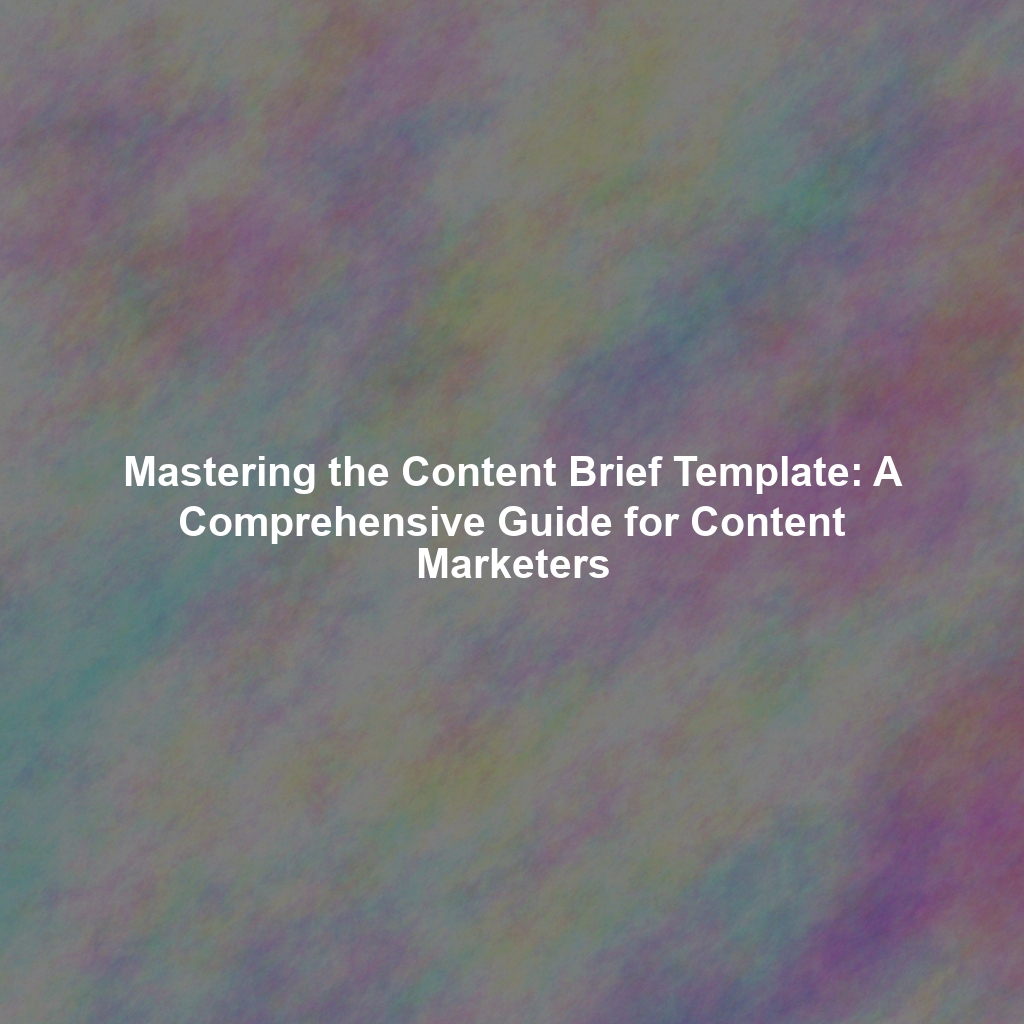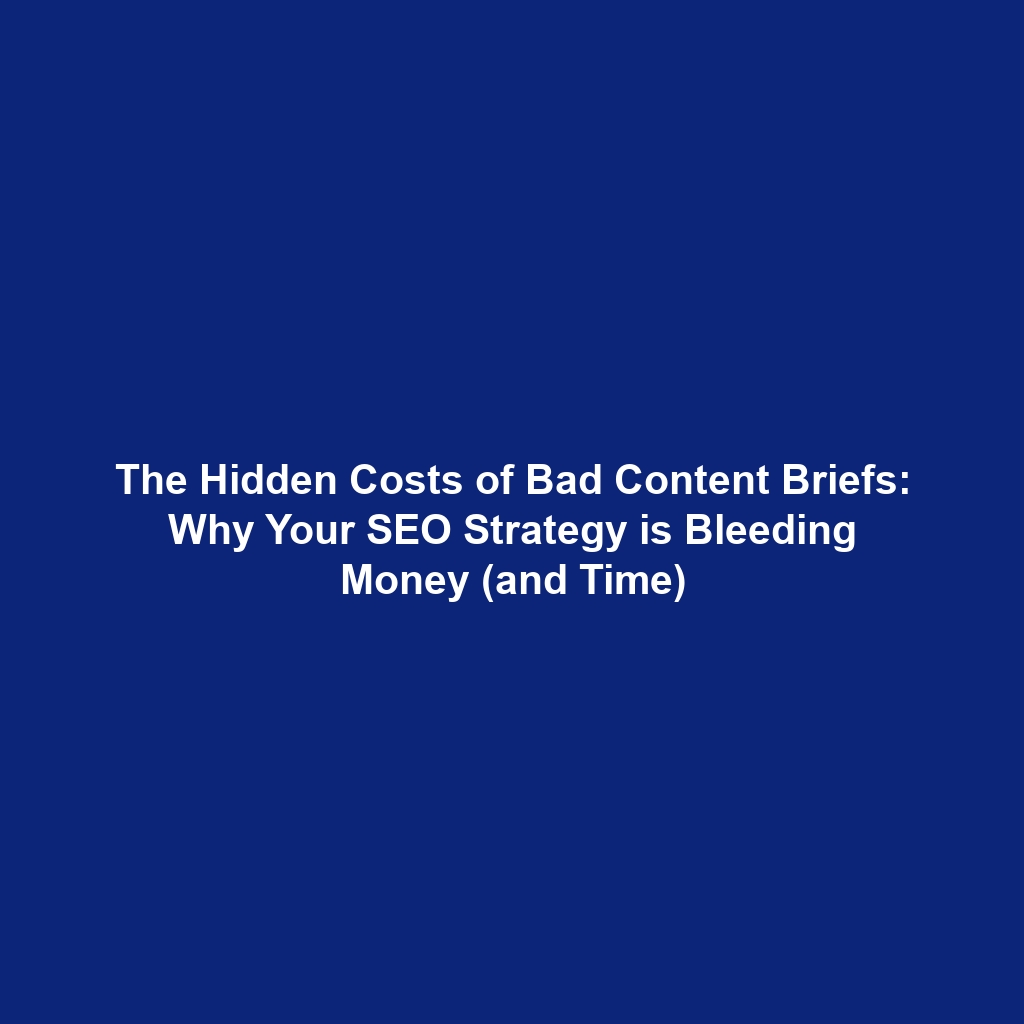Why a Content Brief Template is Essential for Content Marketing Success
In the dynamic world of content marketing, consistency and quality are paramount. A well-structured content brief serves as the blueprint for creating impactful and targeted content. It ensures that everyone involved, from writers and designers to SEO specialists and stakeholders, is aligned on the goals, target audience, and key messages of each piece of content. Without a solid content brief, you risk producing content that misses the mark, wastes resources, and ultimately fails to achieve its intended objectives. This comprehensive guide explores the importance of content brief templates, how to create effective ones, and provides practical tips for implementation.
Understanding the Core Elements of a Content Brief Template
A robust content brief template should encompass several key elements. These elements provide the necessary context and guidance for content creators to produce high-quality, relevant, and engaging material. Let’s break down these essential components:
Project Overview and Goals
Start with a clear and concise overview of the content project. What is the purpose of this content? What problem does it solve for the audience? What are the specific, measurable, achievable, relevant, and time-bound (SMART) goals? For example, a goal might be to increase website traffic by 20% in three months or to generate 50 qualified leads. Clearly define the key performance indicators (KPIs) that will be used to measure success. This section should also include the content type (blog post, infographic, video, etc.) and the target platform (website, social media, email).
Target Audience Definition
A deep understanding of your target audience is crucial. Who are you trying to reach? What are their demographics, interests, pain points, and search behaviors? Create detailed audience personas to provide content creators with a clear picture of who they are writing for. Include information such as age, gender, location, job title, income, and online behavior. Understanding the audience’s motivations and needs will help you create content that resonates with them and drives engagement.
Keywords and SEO Strategy
Search engine optimization (SEO) is a critical component of content marketing. The content brief should outline the target keywords, related keywords, and search intent. Conduct thorough keyword research using tools like Ahrefs or Semrush to identify high-volume, low-competition keywords. Specify the primary keyword, secondary keywords, and long-tail keywords that should be incorporated into the content. Provide guidance on keyword density, placement in headings and body text, and the use of internal and external links. Also, include information about the target search intent: informational, navigational, transactional, or commercial.
Content Outline and Structure
A well-defined content outline provides a roadmap for the content creator. It ensures that the content is logically structured, easy to read, and covers all the essential topics. Break down the content into clear sections and sub-sections, each with a specific heading. Provide a brief description of what should be covered in each section. This helps the writer stay focused and ensures that the content flows smoothly. Consider using bullet points or numbered lists to present information in a concise and digestible format.
Tone and Style Guidelines
Consistency in tone and style is essential for maintaining brand identity. The content brief should specify the desired tone of voice (e.g., professional, conversational, humorous) and style (e.g., formal, informal, technical). Provide examples of existing content that exemplify the desired tone and style. Include guidelines on grammar, punctuation, and formatting. This ensures that all content is consistent with the brand’s overall messaging and voice.
Call to Action (CTA)
Every piece of content should have a clear call to action. What do you want the reader to do after consuming the content? Do you want them to subscribe to your newsletter, download a whitepaper, request a demo, or make a purchase? The content brief should specify the desired CTA and provide guidance on how to incorporate it into the content. Ensure that the CTA is relevant to the content and aligns with the overall goals of the project.
Resources and References
Provide content creators with a list of resources and references that they can use to research and support their writing. This may include links to relevant articles, studies, reports, and competitor content. Providing these resources saves time and ensures that the content is accurate and well-informed. Encourage content creators to cite their sources properly to maintain credibility and avoid plagiarism.
Deadline and Deliverables
Clearly specify the deadline for the content and the expected deliverables. This includes the date the content is due, the format of the content (e.g., Word document, Google Doc), and any specific requirements for submission. This ensures that the content is delivered on time and meets the required standards. Include a clear review and approval process to ensure that the content is reviewed and approved by the appropriate stakeholders before publication.
Crafting an Effective Content Brief Template: A Step-by-Step Guide
Creating a content brief template that works for your organization requires careful planning and consideration. Here’s a step-by-step guide to help you develop a template that meets your specific needs:
1. Identify Your Needs and Goals
Start by identifying your specific content marketing needs and goals. What types of content do you typically create? What are your key performance indicators (KPIs)? What are the biggest challenges you face in content creation? Understanding your needs and goals will help you tailor the template to your specific requirements.
2. Research Existing Templates
Before creating your own template, research existing templates to get inspiration and ideas. There are many free and paid content brief templates available online. Review these templates to identify the elements that are most relevant to your needs. Consider using a combination of elements from different templates to create a customized template that works for your organization.
3. Define the Key Elements
Based on your research and needs assessment, define the key elements that should be included in your template. Refer to the core elements discussed earlier in this guide. Prioritize the elements that are most important for achieving your content marketing goals.
4. Create a User-Friendly Format
Design the template in a user-friendly format that is easy to understand and use. Use clear headings, bullet points, and tables to organize the information. Provide clear instructions and examples to guide content creators. Consider using a digital format, such as a Google Doc or a Word document, to facilitate collaboration and sharing.
5. Test and Iterate
Once you have created your template, test it with a small group of content creators. Gather feedback on the template’s usability and effectiveness. Use this feedback to refine and improve the template. Iterate on the template regularly to ensure that it remains relevant and effective over time.
Best Practices for Using a Content Brief Template
A well-designed content brief template is only effective if it is used properly. Here are some best practices for using a content brief template:
Fill Out the Template Thoroughly
Don’t skimp on details. The more information you provide in the content brief, the better equipped the content creator will be to produce high-quality content. Take the time to research and gather all the necessary information before filling out the template.
Communicate Clearly and Concise
Use clear and concise language to communicate your expectations. Avoid jargon and technical terms that content creators may not understand. Provide examples and illustrations to clarify your points.
Collaborate with Content Creators
Involve content creators in the content brief process. Ask for their input and feedback. This helps them feel ownership of the content and ensures that they understand the goals and objectives of the project.
Review and Approve the Content Brief
Before assigning the content to a creator, review and approve the content brief with all relevant stakeholders. This ensures that everyone is aligned on the goals, objectives, and expectations of the project.
Track Results and Measure Success
After the content is published, track the results and measure the success of the project. Use the KPIs defined in the content brief to assess whether the content achieved its intended goals. Use this data to inform future content briefs and improve your content marketing strategy.
Tools and Resources for Content Brief Creation
Several tools and resources can help you create and manage content briefs more effectively:
- Google Docs: A free and versatile tool for creating and sharing content briefs.
- Microsoft Word: A widely used word processing program for creating and editing documents.
- Trello: A project management tool that can be used to track the progress of content briefs and assignments.
- Asana: Another popular project management tool with features for content planning and collaboration.
- Ahrefs and Semrush: SEO tools for keyword research and competitive analysis.
Examples of Content Brief Template Sections
To illustrate how a content brief template can be structured, here are some examples of content brief template sections and how they might be filled out:
Example: Project Overview and Goals
Content Type: Blog Post
Title: 5 Tips for Improving Your Website’s SEO
Goal: Increase website traffic by 15% in the next quarter.
KPIs: Website traffic, organic search rankings, time on page.
Example: Target Audience Definition
Persona: Marketing Manager, Small Business Owner
Demographics: 30-45 years old, located in the United States, earns $75,000 – $125,000 per year.
Interests: Digital marketing, SEO, social media, content marketing.
Pain Points: Difficulty ranking in search engines, lack of time for SEO, limited budget.
Example: Keywords and SEO Strategy
Primary Keyword: Website SEO
Secondary Keywords: SEO tips, improve website SEO, website optimization.
Long-Tail Keywords: How to improve website SEO for small business, best website SEO tips for beginners.
Search Intent: Informational.
Conclusion: The Power of a Well-Defined Content Brief Template
In conclusion, a well-defined content brief template is an indispensable tool for content marketers and creators. It provides a clear roadmap for creating high-quality, relevant, and engaging content that aligns with your business goals. By following the guidelines and best practices outlined in this guide, you can create a content brief template that empowers your team to produce exceptional content that drives results. Remember to continuously iterate on your template and adapt it to the evolving needs of your audience and the ever-changing landscape of content marketing. Embracing the power of a well-structured content brief template will undoubtedly elevate your content marketing strategy and propel your business to new heights.


